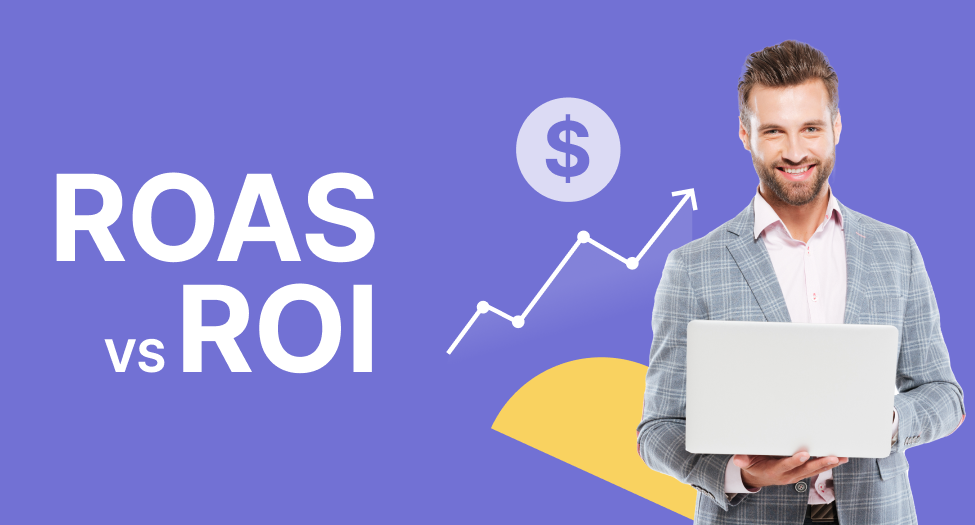Ad campaigns need to have results. Otherwise, they’re just opportunities for marketers to congratulate each other on their creativity. The history of advertising has seen some truly groundbreaking coups of the imagination, from incredible landing pages to tremendous tv ads.
However, they will only have been judged a success if they gave a measurable return. Usually, this will mean a discernible change in consumer behavior.
This is where the measures of ROI (Return On Investment) and ROAS (Return On Ad Spend) come in. They sound like they’re pretty much the same thing. However, there are key differences to consider before deciding on whether to use one or the other, or both?
Return on investment
ROI is the term used to define the results yielded from a given spend. It tells you what you’ve got back as a result of what you’ve put in. It can be any business project, from CapEx to a new post, but in this case, we’re concentrating on advertising campaign spend.
It’s important to understand that ROI should include any collateral spend. This means that it’s often not just about the ad spend itself, but can also cover any necessary training or equipment spend required for the job. All related costs should factor in.
If there’s been any freelance recruitment, for instance, you’d need to include the amount incurred in terms of fee as well as the cost of appointing them, from advertising the position to sending out a freelance recruiter contract.
A simple formula for marketing ROI is as follows:
ROI = (Net Profit/Net Spend) x 100
So, if the marketing costs amounted to $100k and the profit seen as a result was $50k, your marketing ROI figure would be 50% ($50k/$100k = 0.5, x 100 = 50%). This means that for every $1 you spent, you got your costs covered plus $0.50 in profit back.
Remember that net profit is revenue – cost.
Advantages of ROI
- Good for getting a bigger picture of the overall return on spend
- Gives a meaningful idea of where the company is at, performance-wise
Disadvantages of ROI
- Can be time-consuming to identify and work out all the relevant cost figures that need to be included.
Return on ad spend
The other commonly used metric in this area is ROAS. This is a means of discovering the effectiveness of expenditure, using the following formula:
ROAS = (Revenue/Cost) x 100
So if an ad campaign cost $50,000 and the revenue yielded was $150,000, the ROAS figure would be 300%. This means that for every $1 you spent, you got $3 back.
This figure takes as its exclusive focus the cost of the actual ad and the income generated from it. It doesn’t include associated spend on related fields.
Advantages of ROAS
Gives an idea of how a specific ad performed
Gives data on how channels are delivering
Is relatively easy and quick to perform
Disadvantages of ROAS
There’s just one big one. It doesn’t give the whole picture.
The difference between ROI and ROAS
The two can be looked at like this. ROI is a much broader tool, taking into account a raft of associated expenditures, which it factors into every endeavor to give as accurate a profit picture as possible. ROAS is a much more tightly focused approach, which is concerned just with the performance of a specific ad campaign.
They both have their strengths, depending on what information you want. And, as we’ll see, the differences in qualities between the two tools make them great for use in tandem.
How do you work out results?
Of course, one of the biggest challenges is deciding exactly how much of a company’s profits that period was down to the ad campaign. This is a problem common to both ROI and ROAS.
Sometimes it’s easy – it can be based on something distinctly to do with the campaign, like tracking the use of a code that’s promoted in the ad. Sometimes, you’ll need to use techniques such as surveys and focus groups; to track improvements in brand awareness, for example.
Once you have an idea of how much brand exposure you’ve achieved in your ad campaign, you need to apply a monetary value to that exposure. This is in order to get a meaningful ROI or ROAS figure.
Other metrics that can be used to analyze an ad campaign include number of clicks, social media shares, new customers, conversions, and leads generated. As well as the impact it may have on average order value, time spent on site, and even the nature of the comments the company is receiving.
All of these KPIs will need to have a monetary figure placed on them so that your ROI or ROAS makes sense. How you go about this will vary from business to business: a positive comment will mean more to one company than another, for instance.
ROI vs ROAS? Either or both?
If you’re engaged in a lengthy brand overhaul, you might want to measure how much effect this has had on your customer base relative to how much it has actually cost the company. This may take a great deal of time and be ranged across many different platforms.
The best chance of gaining an accurate idea of how much it will cost you is to factor in all the relevant advertising costs accrued across the project. Converting the pertinent KPIs to a financial figure will then allow you to see how much the whole marketing effort has delivered vs its required outlay. This is your ROI.
However, as part of this brand makeover, you might want to try a means of promotion that includes, say, discount codes or a free proposal software offer. To push this there might be a specific ad that you’d like to know the effectiveness of, relative to its cost.
You’re not bothered about the associated costs that have racked up during the whole campaign. You just want to know how much the ad cost and how much it made so that you can see how effective this one component was.
This is especially useful in the omnichannel world, where companies need to know which route gives the best bang for their buck.
So you take the results of the ad in terms of new customers or whatever KPI you’ve decided to use, you convert that figure to a monetary value and you divide that by the expenditure that you’ve laid out just on that one ad. This is your ROAS.
By using them both, it’s possible to get a detailed picture of your business ad campaign outlay. You can use ROI for the broader, macro perspective, which is what your shareholders are going to be primarily interested in. And you can use ROAS to decide which particular ad had the best effectiveness and efficiency.
An example

So, let’s say you have a business selling contract management software. You want to run an ad campaign, promoting the business to a fresh sector, and you’d like to do so with the use of three channels: email marketing, outbound phone calls, and an online advertising campaign (a Facebook ad).
The email marketing goes like this. You send out all the information regarding your software’s contract management features, which costs your business $500. It results in $7500 in revenue.
The outbound phone calls are not so effective. There was an unfortunate phone price hike just as the effort started so the cost of making the calls is $1500. It nets $1000 in revenue.
The Facebook ad costs $12000 in terms of time spent generating and posting the content. Revenue amounts to $20000.
So, let’s start with ROAS and apply it to each effort in turn.
The email channel: $7500/$500 = 15. Multiplied by 100 = 1500%.
The outbound phone channel: $1000/$1500 = 0.67. Multiplied by 100 = 67%.
The Facebook channel: $20000/$12000 = 1.67. Multiplied by 100 = 167%.
So, ROAS tells us that the email channel was way more cost-effective than either of the other two routes. This makes sense – email is often at the center of the most highly cost-effective campaigns.
What about ROI? Let’s use it to analyze the entire marketing campaign.
Email channel – we need to factor in extra costs including all the staffing and the expense of equipment and premises. So, this gives a total cost of $4000.
Outbound phone channel – again, all staffing, equipment, and premises costs = $4500
Facebook ad channel – to prepare the ad in the first place, together with cost to advertise = $14000
ROI then works like this:
Profit = $6000 (ie, $28500 total revenue – $22500 total cost).
$6000/$22500 = 0.26. Multiplied by 100 = 26%. In other words, every $1 spent generated $1.26 in revenue, meaning $0.26 in profit.
Summing up
So, you can see that ROI and ROAS are techniques that give very different results so are commonly used by different types of analysts. If you’re just wanting to see how well an ad channel works when rated against other channels, use ROAS. If, on the other hand, you want a good picture of how financially healthy the whole advertising strategy is, use ROI.
But for those who want both the macro and the micro levels of information, use both. You’ll get a far more comprehensive understanding of ad campaigns if you do. So, in the case of ROI vs ROAS, it’s both, not either.







